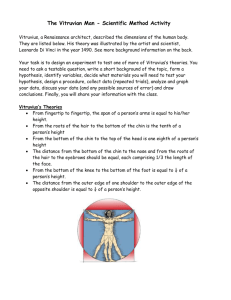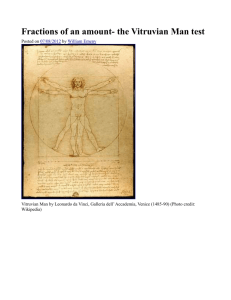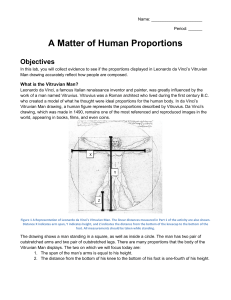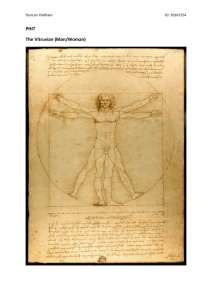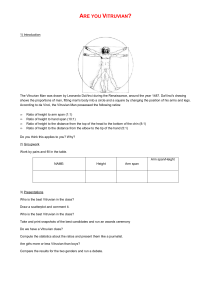Be sure and pay attention to the presentations made by
advertisement
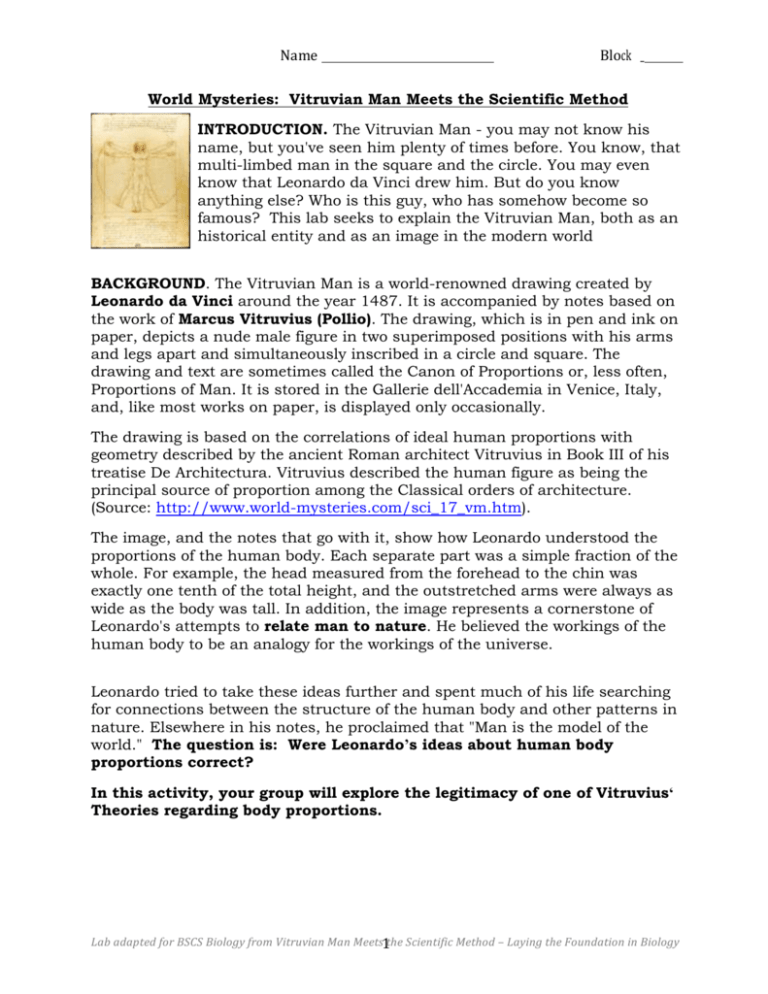
Name Block _ World Mysteries: Vitruvian Man Meets the Scientific Method INTRODUCTION. The Vitruvian Man - you may not know his name, but you've seen him plenty of times before. You know, that multi-limbed man in the square and the circle. You may even know that Leonardo da Vinci drew him. But do you know anything else? Who is this guy, who has somehow become so famous? This lab seeks to explain the Vitruvian Man, both as an historical entity and as an image in the modern world BACKGROUND. The Vitruvian Man is a world-renowned drawing created by Leonardo da Vinci around the year 1487. It is accompanied by notes based on the work of Marcus Vitruvius (Pollio). The drawing, which is in pen and ink on paper, depicts a nude male figure in two superimposed positions with his arms and legs apart and simultaneously inscribed in a circle and square. The drawing and text are sometimes called the Canon of Proportions or, less often, Proportions of Man. It is stored in the Gallerie dell'Accademia in Venice, Italy, and, like most works on paper, is displayed only occasionally. The drawing is based on the correlations of ideal human proportions with geometry described by the ancient Roman architect Vitruvius in Book III of his treatise De Architectura. Vitruvius described the human figure as being the principal source of proportion among the Classical orders of architecture. (Source: http://www.world-mysteries.com/sci_17_vm.htm). The image, and the notes that go with it, show how Leonardo understood the proportions of the human body. Each separate part was a simple fraction of the whole. For example, the head measured from the forehead to the chin was exactly one tenth of the total height, and the outstretched arms were always as wide as the body was tall. In addition, the image represents a cornerstone of Leonardo's attempts to relate man to nature. He believed the workings of the human body to be an analogy for the workings of the universe. Leonardo tried to take these ideas further and spent much of his life searching for connections between the structure of the human body and other patterns in nature. Elsewhere in his notes, he proclaimed that "Man is the model of the world." The question is: Were Leonardo’s ideas about human body proportions correct? In this activity, your group will explore the legitimacy of one of Vitruviusʻ Theories regarding body proportions. Lab adapted for BSCS Biology from Vitruvian Man Meets1the Scientific Method – Laying the Foundation in Biology Name Block _ OBJECTIVES Students will: devise and test a hypothesis regarding Vitruvius’s human proportions theory understand the difference between accuracy and precision understand and utilize the steps of the scientific method to make measurements and observations to test their hypothesis be able to identify independent, dependent, and controlled variables in their experiment create data tables and graph(s) to best present data design an electronic poster illustrating how the scientific method was used to test a hypothesis and draw conclusions METHODS/PROCEDURES Your task is to design an experiment to test ONE of Vitruvius’s theories on yourselves: 1. propose a question and state your hypothesis (If….then statement) 2. design a procedure to test your hypothesis 3. collect data from a minimum of 3 repeated trials 4. organize data into data table(s) 5. analyze and graph your data 6. draw conclusions 7. Create (and present) an electronic “poster” in order to share your information with the class VITRUVIUS’ IDEAS 1. From fingertip to fingertip, the span of a person’s arm is equal to his/her height. 2. From the roots of the hair to the bottom of the chin is a tenth (1/10) of a person’s height. 3. From the bottom of the chin to the top of the head is one eighth (1/8) of a person’s height. 4. The distance from the bottom of the chin to the nose and from the roots of the hair to the eyebrows should be equal, each comprising one-third (1/3) the length of the face. 5. From the bottom of the knee to the bottom of the foot is equal to one-fourth (1/4) of a person’s height 6. The distance from the outer edge of one shoulder to the outer edge of the opposite shoulder is equal to one-fourth (1/4) of a person’s height. Lab adapted for BSCS Biology from Vitruvian Man Meets2the Scientific Method – Laying the Foundation in Biology Name Block POSTER INFORMATION and SCORING RUBRIC Poster (30 pts) should include: 1 pt Title 1 pt Question 2 pts Testable Hypothesis 4 pts Materials and Methods (procedures w/ pictures) 3 pts Data (organized into a table or tables) 4 pt Graph of data (YOU must decide type of graph (line, bar, pie) to BEST represent your data 6 pts Conclusion (restate hypothesis; identify the independent and dependent variables; identify your controlled variables, was your hypothesis supported or refuted? Explain; identify at least 2 sources of error; identify one thing you want to know more after doing this lab 1 pt Citations (where you got your info and pics from) 5 pts Presentation (2-4 minutes) 3 pts Peer Evaluation Posters must be created using Pages; fonts no smaller than 10 Posters must be emailed to brnacua@ksbe.edu only once (one email per group; I will grade the first email I receive, if you attempt to send more than one; no later than 3:30pm on Wednesday, January 21. Be sure to cc all group members to ensure sending and so I can see who is in each group. Posters will be presented on Thursday, January 22. All members must have a speaking role. Be creative (yet appropriate) in your posters and presentations. For instance, if you want to take on the role of da Vinci or Vitruvius, you may do so. Include graphics as well. The goal of your poster and presentation is to inform the class of your research and findings while keeping their attention. Presentations should be 2 – 4 minutes in length. You will receive a 1 point deduction for each minute under or over. AT THE END OF THIS LAB ACTIVITY At the end of this lab activity, you should be able to answer the following questions: 1. Which, if any, of Vitruvius’s Theories were supported (by you or your classmates)? 2. Which, if any, of Vitruvius’s Theories were refuted (by you or your classmates)? 3. How does the distance from fingertip to fingertip relate to the span of a person’s arms? 4. How does the distance from the roots of the hair relate to the bottom of the chin? 5. How does the distance from the chin to the top of the head relate to a person’s height? Lab adapted for BSCS Biology from Vitruvian Man Meets3the Scientific Method – Laying the Foundation in Biology Name Block 6. How does the distance from the bottom of the chin to the nose and from the roots of the hair to the eyebrows relate to the length of the face? 7. How does the distance from the bottom of the knee to the bottom of foot relate to a person’s height? 8. How does the distance from the outer edge of ones shoulder to the outer edge of the opposite should relate to a person’s height? 9. What are the 6 steps of the scientific method? 10. Why is it necessary to perform 3 repeated trials? 11. What is the difference between accuracy and precision? Be sure and pay attention to the presentations made by your classmates so you can correctly answer the above questions! "A painter should begin every canvas with a wash of black, because all things in nature are dark except where exposed by the light." — Leonardo da Vinci "Study without desire spoils the memory, and it retains nothing that it takes in." — Leonardo da Vinci "If nature has composed the human body so that in its proportions the separate individual elements answer to the total form, then the Ancients seem to have had reason to decide that bringing their creations to full completion likewise required a correspondence between the measure of individual elements and the appearance of the work as a whole." — Marcus Vitruvius Pollio Lab adapted for BSCS Biology from Vitruvian Man Meets4the Scientific Method – Laying the Foundation in Biology

